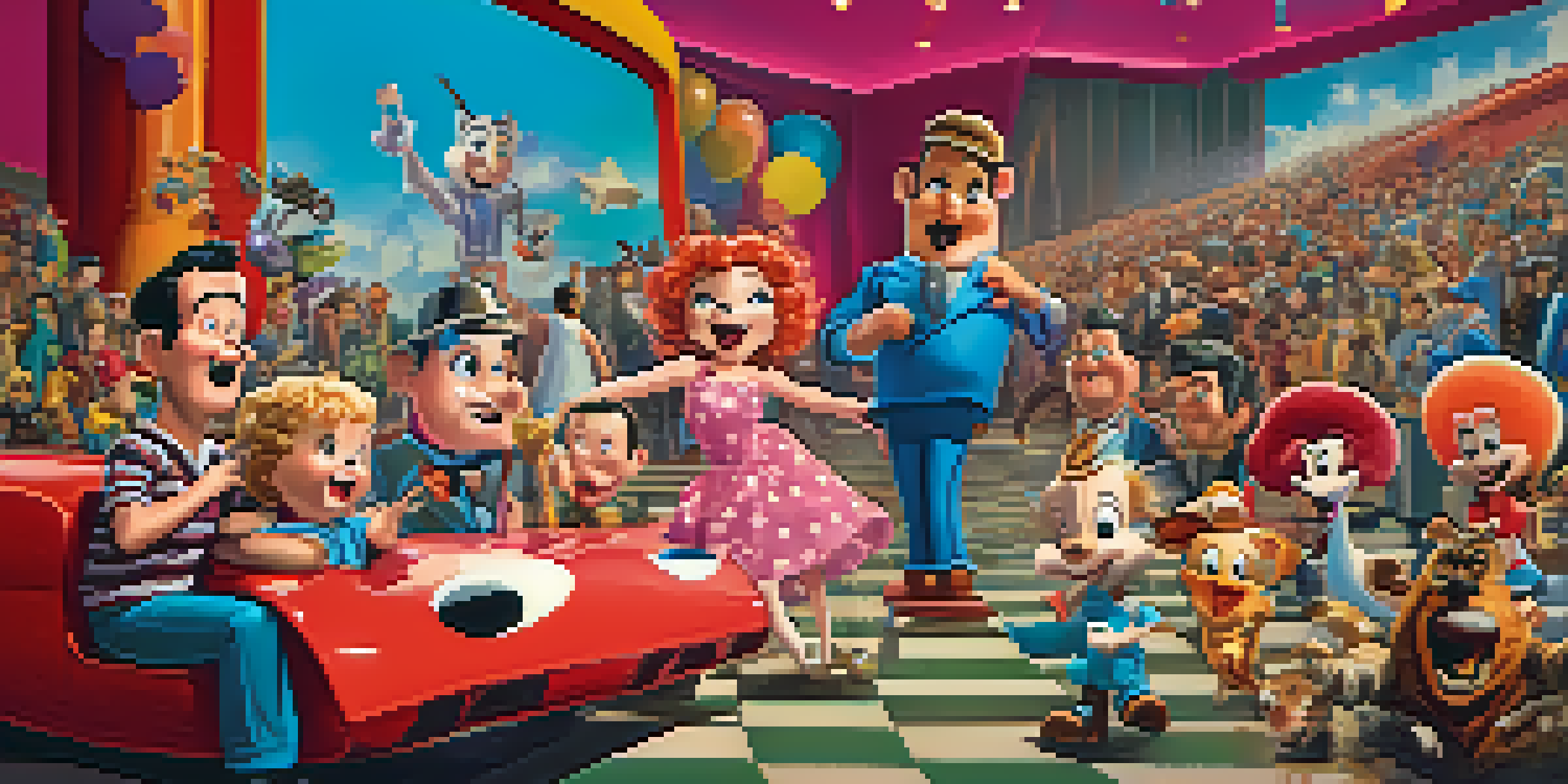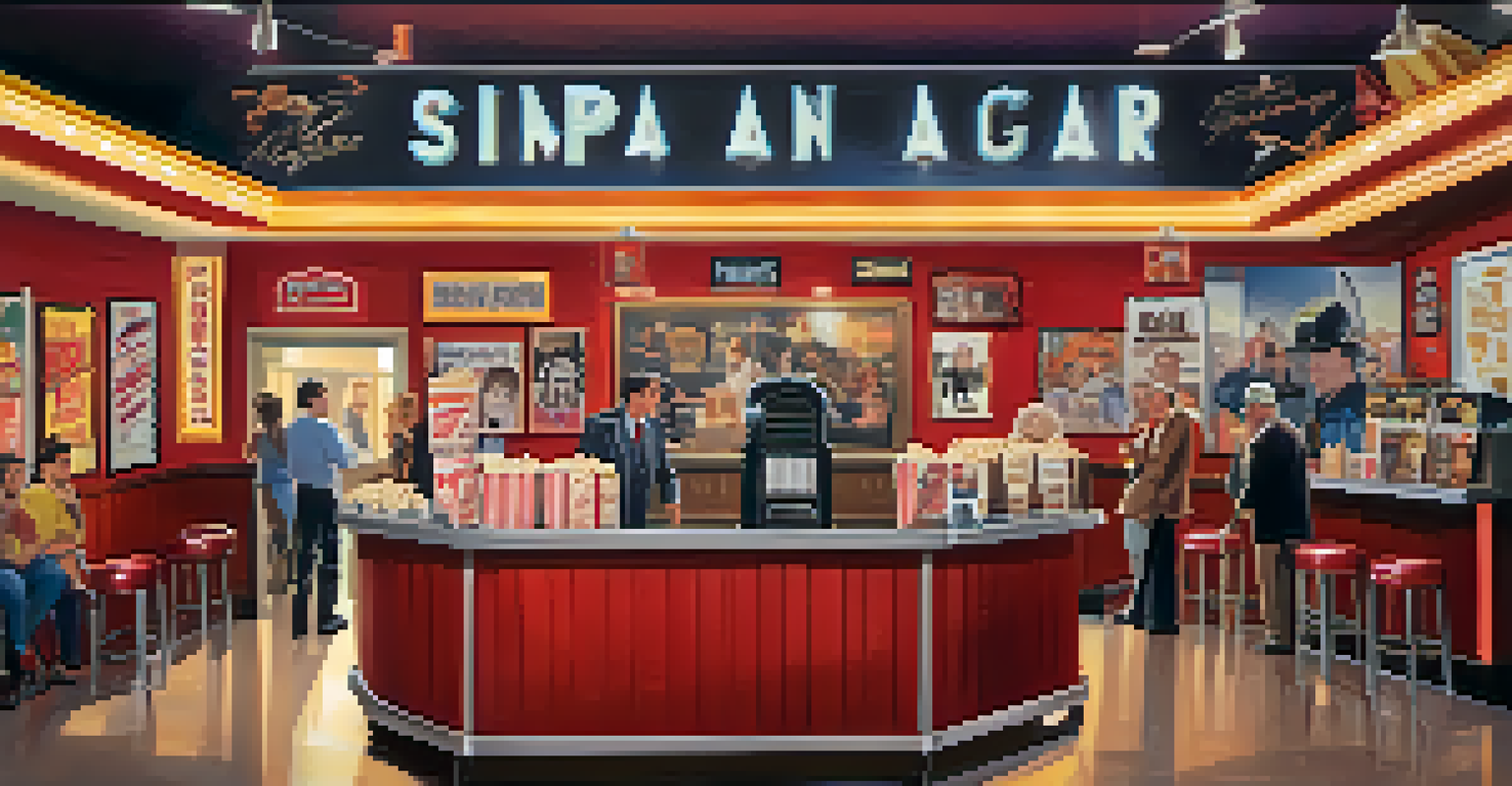How Parody Films Shape Audience Perceptions of Genres

Understanding Parody Films and Their Appeal
Parody films are comedic works that mimic and exaggerate the conventions of other genres. They often take familiar tropes and twist them, creating a humorous reflection of what we know. This approach not only entertains but also invites viewers to question the norms of the original genre being parodied.
Parody is the ultimate form of flattery. It’s also the best way to make fun of something you love.
For example, movies like 'Scary Movie' take well-known horror films and turn them on their head. By doing so, they highlight the absurdities and clichés present in those films, making audiences reconsider how they view them. This blend of humor and critique can provoke a deeper understanding of genre conventions.
Ultimately, parody films serve as a mirror, reflecting both the strengths and weaknesses of their source materials. They create a space where viewers can laugh while also engaging critically with the content, shaping their perceptions in the process.
How Parody Films Challenge Genre Norms
One significant impact of parody films is their ability to challenge established genre norms. By exaggerating common traits, these films often expose the predictability and formulaic nature of traditional storytelling. This can lead audiences to become more discerning viewers, questioning the authenticity of the genres they consume.

Take 'Not Another Teen Movie,' for instance, which plays with the clichés of teen romances and comedies. By poking fun at these tropes, the film encourages viewers to think critically about the messages and expectations that come with such genres. It becomes a playful yet insightful commentary on the genre's limitations.
Parody Films Challenge Norms
Parody films expose and critique the predictable elements of established genres, prompting audiences to reassess their viewing preferences.
As audiences engage with these humorous critiques, they may find themselves reassessing their preferences and expectations. This process of reevaluation can lead to a more nuanced understanding of genres and a greater appreciation for the creativity involved in subverting them.
Parody Films as Cultural Commentary
Beyond simple humor, parody films often serve as a form of cultural commentary. They can reflect societal attitudes and norms, using comedy as a tool to address serious issues. By holding a mirror to our culture, parody films can spark important conversations about the genres they mimic.
Humor is a great way to explore the absurdities of life, and parody films do this in a way that both entertains and provokes thought.
For example, 'Airplane!' cleverly critiques the absurdity of disaster films while also commenting on broader themes of fear and heroism. This dual-layer of humor allows audiences to laugh while also reflecting on the deeper implications of the narratives. It transforms a simple comedic experience into a thought-provoking one.
As a result, parody films can shape audience perceptions not just of specific genres, but of cultural narratives as a whole. They encourage viewers to think critically and engage with content on multiple levels, making them an essential component of the film landscape.
The Role of Nostalgia in Parody Films
Nostalgia plays a crucial role in the effectiveness of parody films. By referencing beloved classics, these films tap into the audience's fond memories, creating a connection that enhances the comedic experience. This nostalgia not only elicits laughter but also allows for a deeper appreciation of the genres being parodied.
Consider films like 'The Lego Movie,' which cleverly incorporates elements from various genres while invoking a sense of nostalgia for childhood. By blending humor with familiar references, it creates a rich tapestry that resonates with viewers of all ages. This connection can lead to a renewed interest in the original genres.
Cultural Commentary Through Humor
These films use comedy to reflect societal attitudes and provoke discussions about deeper cultural narratives.
As viewers laugh at the parodied elements, they may also find themselves reflecting on why these genres were significant to them. This dual engagement makes parody films not just a source of entertainment, but also a catalyst for exploring personal and cultural connections to different genres.
Influencing Audience Expectations and Future Films
Parody films can significantly influence audience expectations for future films. By setting a new standard for humor and storytelling, these films challenge filmmakers to innovate and push boundaries. This influence can lead to a shift in how genres are approached and produced, making way for more diverse narratives.
For example, after the success of 'Shaun of the Dead,' we saw a surge in horror-comedy hybrids. This shift demonstrates how parody can reshape the landscape of cinema, encouraging filmmakers to explore new combinations and styles. Audiences, in turn, begin to expect a blend of humor and genre conventions in their viewing experiences.
As a result, parody films play a pivotal role in shaping not only audience perceptions but also the future of genre filmmaking. They open the door for experimentation and creativity, leading to fresh narratives that keep audiences engaged and entertained.
The Impact of Social Media on Parody Films
In today's digital age, social media has amplified the reach and impact of parody films. Platforms like Twitter, TikTok, and Instagram allow users to share and create parody content rapidly, leading to a blend of traditional film and user-generated humor. This democratization of parody adds layers to how genres are perceived.
For instance, viral videos that parody popular films can create a buzz around the original content, inviting new audiences to engage with the genres being spoofed. This phenomenon can lead to a resurgence of interest in older films or a new appreciation for genre tropes that were once overlooked.
Nostalgia Enhances Viewer Connection
By referencing beloved classics, parody films create a nostalgic bond that enriches the comedic experience and encourages reflection on original genres.
Moreover, social media encourages dialogue about parody films, allowing audiences to share their thoughts and interpretations. This interaction fosters a community of viewers who can collectively shape their perceptions of genres, creating a dynamic landscape where parody thrives and evolves.
Conclusion: The Lasting Influence of Parody Films
In conclusion, parody films play a vital role in shaping audience perceptions of genres. They challenge norms, provoke thought, and invite laughter, all while encouraging viewers to engage critically with the content. Through humor and cultural commentary, these films create a unique space for exploration and reflection.
As audiences continue to embrace parody films, they not only entertain but also influence how genres are understood and appreciated. This interplay between humor and critique ensures that parody remains a powerful tool in the film industry.

Ultimately, the legacy of parody films lies in their ability to connect with audiences on multiple levels, making them an essential part of the cinematic experience. As we look ahead, it's clear that the impact of parody will continue to resonate in the evolving landscape of film and genre.